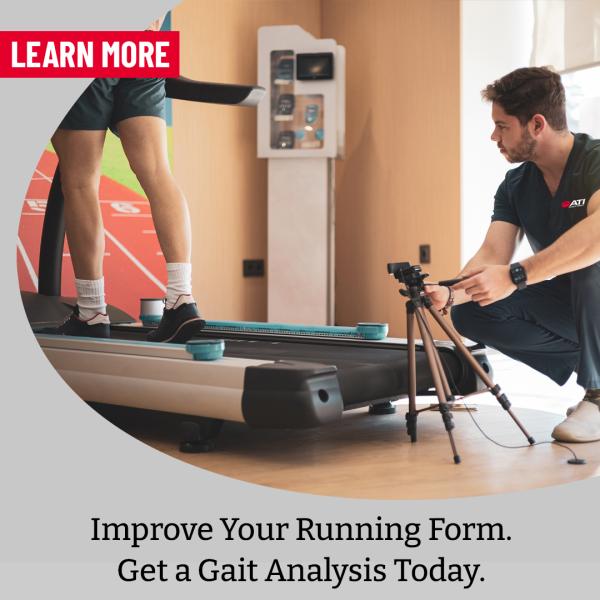
Reviewed and contributions made by Caitlin Ludington, DPT, SCS
There are a variety of common injuries that can plague a runner. Injuries include stress fractures, strains and sprains. As in any sport, improving your technique (and, in this case, your gait) can help runners perform better and prevent injuries.
ATI Physical Therapy can assess and correct your gait form and body’s biomechanics. Our analysis examines two views of available motion and control. These views allow our specialists to identify issues and recommend exercises.
Get Your Free Physical Therapy Screening
Want to discover how you can benefit from physical therapy? Get a free screening and let us help you start the path to recovery today.
GET MY COMPLIMENTARY SCREENING
What is the running gait cycle?
Your running gait is how you move your body – especially your lower limbs - during running. Your genetics, posture and even your footwear all influence how your foot strikes the ground when you run.
Your gait is often described as a cycle and is divided into two phases:
- Stance/support phase: When one foot is in contact with the ground.
- Swing/recovery phase: When both feet are off the ground.
The cycle begins when one foot meets the ground and then ends when the same foot contacts the ground again. Noting the cycle will help you understand your running gait type.
Running gait types
All gait, walking and running involves pronation. How much pronation you have determines the “type” of running you do. It should be noted that no gait is better than another. What is important is understanding how you move.
There are three different running types:
- Under pronation/supination: The foot rolls inward less than 15% when it meets the ground. Runners with high arches are more likely to under pronate.
- Neutral/normal: The foot rolls inwards by 15%. The ankle and leg remain in alignment.
- Overpronation: The foot rolls inward more than 15%. Runners with low arches or flat feet are more likely to overpronate.
Why get a running gait analysis?
Your running gait indicates how your body moves during activity. Understanding your gait can reveal muscle weaknesses and/or bodily imbalances. It also shows how your body compensates for either.
Like with any sport, knowing your weaknesses allows you to create a plan towards progress. Improving your form and using the proper gear can yield better performance. Most importantly, identifying and then correcting weakness and imbalances can help prevent injury.
How gait analysis works
You will be asked to run on a treadmill or over ground. While you are running, the person conducting the analysis will record you from different angles.
During the observation, the practitioner will identify the following:
- Your step and stride length
- Pronation (i.e., the way which your foot interacts with the ground)
- Cadence (i.e., the number of steps you take in a set timeframe)
- Point of contact (i.e., the part of your foot that first meets the ground)
- Swing time
- Foot and hip angle
More detailed observations may include your force, speed and weight distribution while running.
Who can benefit from running form analysis?
While runners of all levels can benefit, a gait analysis can help anyone. Gait analysis will help identify:
- Muscle weakness
- Muscle tightness
- Imbalances
- Compensations
- Shoe recommendations
- How to improve speed, performance and efficiency
The analysis and training that follows can improve your ability to walk, run and even stand. It will strengthen your muscles, level out imbalances and help you decide what shoes to wear.
Why choose ATI for gait analysis and training?
Following your video gait analysis session, you will receive a comprehensive report. The report will include individualized comments and images. You will also be given suggestions and exercises to address any imbalances your analysis shows to improve your form and efficiency.
If you’d like to take it a step further, a physical therapist can design a full balance and gait training program for you to aid in recovery, prevent injury and help you move better overall. Take the first step and learn how to move better today.
